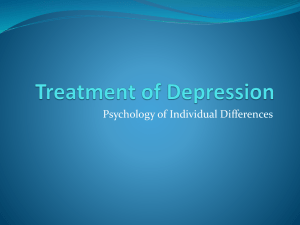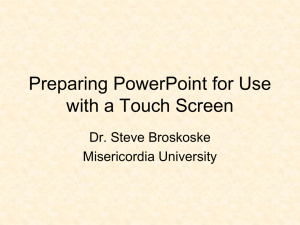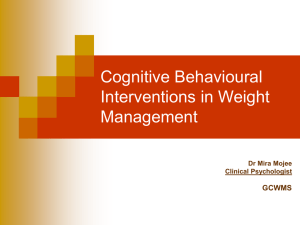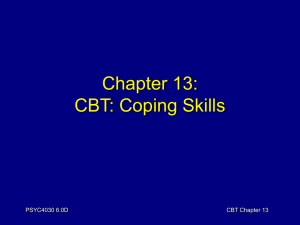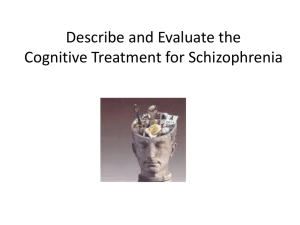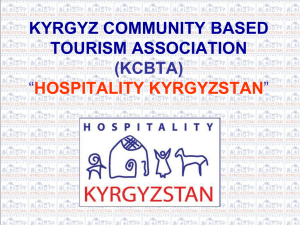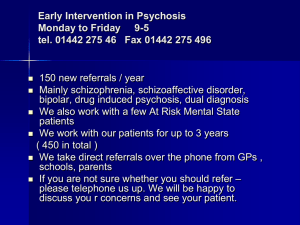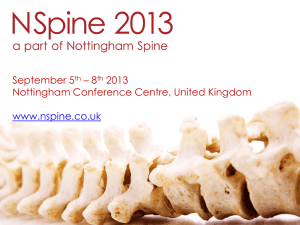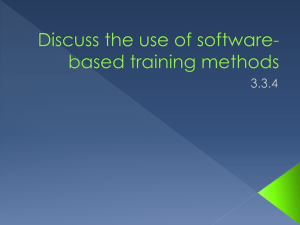CBT for Depression - Anxiety Disorders Association of America
advertisement
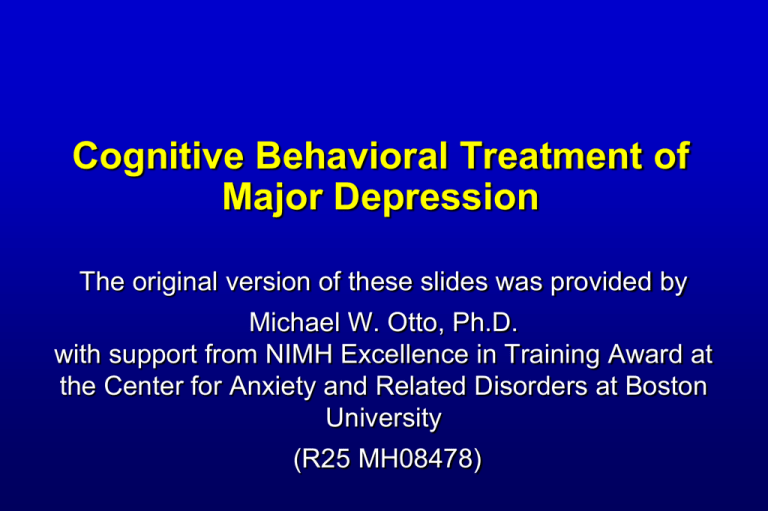
Cognitive Behavioral Treatment of Major Depression The original version of these slides was provided by Michael W. Otto, Ph.D. with support from NIMH Excellence in Training Award at the Center for Anxiety and Related Disorders at Boston University (R25 MH08478) Use of this Slide Set Presentation information is listed in the notes section below the slide (in PowerPoint normal viewing mode). References are also provided on the slide, or at times, in the note sections. Why Consider CBT for the Treatment of Major Depression? Acceptable Recent meta-analysis indicates that psychotherapy is preferred 3:1 to pharmacotherapy for depression (McHugh et al., 2013, J Clin Psychiatry) Efficacious and Cost-Effective CBT is more cost-effective than pharmacotherapy over follow-up periods) (Dobson et al. 2009; Hollon et al. 200x) Long-term Maintenance of Gains – – – CBT has a strong enduring effect over time (Cuijpers et al., 2013, BMJ open) CBT Efficacy Extends Across Settings 1. From the Research Clinic to the Outpatient Clinic Outpatient CBT in clinical settings offers significant benefits, although… – – According to meta analysis, the degree of benefit offered by CBT in the clinic may be somewhat less than what is achieved in controlled clinical trials, it still reflects important benefit on both depression (d=1.13) and secondary outcomes (d=.67-.88) for within subject benefits Dropout rates for such treatment are in the range of 25% (Hans & Hiller, 2013, JCCP) CBT Efficacy Extends Across Settings 2. Across Formats/Patient Subgroups CBT for depression offers Benefits when offered in a group, albeit less than achieved in individual therapy, but this difference is attenuated over time (Hunt et al., 2012, Br J Psychiatry, 200, 184-90). Benefit for older people as judged by meta analysis of 23 studies (Gould et al., 2012, J Am Geriatr Soc, 60, 1817-30) Similar gains in those with and without disability benefits (Ebrahim et al., 2012, PLoS One) Benefit when offered as a brief (6 to 8 sessions) treatment (controlled effect size = .42) (Nieuwsma et al., 2012, Int J Psychaitri Med, 43, 129-51) Benefit for medical populations such as cancer patients (check Hart et al., 2012, J Natl Cancer Inst, 2012, 104: 990-1004). CBT vs. Other Psychotherapies CBT and IPT appear to offer similar outcomes when offered for unipolar depression – (Jakobsen et al., 2012, Psychol Med, 42, 1343-1357) Similar outcomes for Cognitive Therapy (CT) and Behavioral Activation (BA), with advantages over supportive therapies (Braun et al., 2013, Plos One) Whether CBT differs from focused dynamic therapy or supportive therapy depends on the specific studies included in metaanalyses (cf., Tolin, 2010, Clin Psychol Rev; Braun et al., 2013) Perspectives on More Severe Depression Early evidence that ADM may outperform CBT for moderate to severe depression (Elkins et al., 1989)… …But this association has not stood up in subsequent trials (e.g., DeRubeis et al., 2005), with evidence that CBT offers protection from relapse (Hollon et al., 2005, Arch Gen Psychiatry) in these patients See the following example findings… DeRubeis et al, 2005 Arch Gen Psychiatry CT vs. ADM vs. Placebo for Moderate to Severe Depression Sustained Improvement (Hollon et al. 2005, Arch Gen Psychiatry) CBT Helps Protect Against Relapse Meta-Analysis of Acute Phase Treatment (ADMs were discontinued) (Vittengl et al., 2009; JCCP) CT vs. ADM (7 studies): CT associated with a 61% less relapse/recurrence – Addition of CT to pharmacotherapy (6 studies): adding CT associated with a 61% less relapse/recurrence Example Study (Dobson et al., 2008, JCCP) – – CT and Behavioral Activation (BA) each equal to continuation of medication and better than ADM withdrawal for protecting against relapse (BA at a trend-level advantage) CBT for Medication-Resistant Depression Fava et al., 1997 19 Patients who failed 2 trials of ADMs Mean 15 4 sessions of CBT 63% remission rate Maintenance at two years (83%) Residual Symptoms and Relapse Residual symptoms are a predictor of relapse over time (Jarrett et al., 2008, J Affect Disord), encouraging full treatment of depression before cessation of treatment Example Study (Thase et al., 1992) – 9 % Relapse among full responders – 52 % Relapse among patients with residual symptoms CBT for Prevention of Recurrent Depression 40 recovered outpatients Random assignment to CBT or clinical management (CM), tapering of ADMs 2-yr relapse rates: – – CBT CM 25% 80% (Fava et al., 1998) Ratings of Therapeutic Alliance CBT > Psychodynamic-Interpersonal Alliance was correlated with impact (helpfulness) of the session (Raue et al., 1997) Behavioral Activation (BA) Treatment A nice reminder that “doing” in therapy is important Primary treatment strategies – – – Self-monitoring of daily activities and mood Week-by-week scheduling of activities that bring patients a sense of pleasure or mastery Identifying and reducing avoidance behaviors that increase depressive symptoms. In the last decade, BA has enjoyed diverse application as a brief treatment BA typically has received less attention than CT, despite evidence of similar efficacy (e.g., Dimidjian et al., 2006, JCCP 2006; Jacobson et al., 1996, JCCP) BA has been shown to be efficacious for treatment of depression across a diverse array of samples (e.g., inpatients, patients with cancer, smokers). Adaptable in length – 6-session BA treatment for illicit drug users significantly reduced depressive symptoms (Magidson et al., 2011) – Potential role in early intervention: A single session of BA followed by two weeks of activity assignments reduced depressive symptoms in undergraduates (d = 1.61) (Gawrysiak et al., 2009, J Counseling Psych) Problem Solving Interventions Strong effect sizes for problem solving therapy for depression (Bell & E’Zurilla, 2009, Clin Psychol Rev) Elements: – – Training in a positive problem orientation Training in problem-solving skills: problem definition and formulation generation of alternatives decision making solution implementation and verification Treatment Considerations Structure of the Session Each session, with its assessment of emotions and alternative responses, allows the therapist to model emotional regulation and problem solving Therapist models responses to: emotions problems change process Structure of Sessions Review of symptoms, progress, and problems Construction of the agenda Discussion, problem solving, rehearsal Consolidation of new information/strategies Assignment of home practice Troubleshooting of homework (including signposts of adaptive change) CBT: A Collaborative Effort Active collaboration (patient as cotherapist) Review of the week, rehearsals, roleplays and other active practice in session Practice of skills in life through weekly assignments ranging from monitoring of thoughts and other behaviors to rehearsal of skills in specific contexts Session 1 - Establishing a Cotherapist on the Case To help the patient be an active cotherapist in treatment, provide a: Model of the disorder Model of the change process Information on the role of the patient Elements of Treatment Cognitive Restructuring and Skill Acquisition Restructuring Education (role and nature of thoughts) Self-monitoring of thoughts Identification of errors Substitution of useful thoughts Core beliefs and strategies Skill acquisition Assertiveness Communication skills Problem solving Cognitive Restructuring Examine the evidence for the thought Generate alternative explanations De-catastrophize Debunk “shoulds” Find the logical error Test out its helpfulness Questions Used to Formulate Rational Response What is the evidence that the automatic thought is true? Not true? Is there an alternative explanation? What is the worst that could happen? Would I live through it? What’s the best that could happen? What’s the most realistic outcome? Questions Used to Formulate Rational Response (Cont’d) What is the effect of my believing the automatic thought? What is the cognitive error? If a friend was in this situation and had this thought, what would I tell him/her? Targets for Cognitive Restructuring Emotional tone of self talk Distortions in interpretations of events Core beliefs Development of adaptive thinking Respecting Hot Emotions Interventions are in relation to, not in spite of, the patient’s current mood. Attention to current mood states helps the therapist get access to mood-state dependent cognitions Behavioral Activation (BA) Treatment Self-monitoring of daily activities and mood Week-by-week scheduling of activities that bring patients a sense of pleasure or mastery Identifying and reducing avoidance behaviors that increase depressive symptoms. Activity Assignments - 1 Used in conjunction with cognitive restructuring Help ensure that therapy is not overfocused on thinking rather than doing Starts with monitoring of activities and setting of goals for valued activities for both pleasure and mastery (competence goals) Activity Assignments - 2 When structuring assignments Start where the patient is Be specific about assignments (defining desired outcomes specifically) Rehearse elements in session Troubleshoot problems and signposts Review cognitions (expectations and concerns) Activity Assignments - 3 Review performance relative to objective criteria (and the degree of mood disturbance) Assess the patient’s cognitive and affective response to the activity Discuss next steps Well-Being Therapy Phase Consolidate skills Focus on increasing the positive not just reducing the negative Fade out treatment Relapse Prevention Metacognitive Awareness Classic CT and Mindfulness-based CT both enhance metacognitive awareness Level of metacognitive awareness is linked to relapse Changing the relationship people have to their thoughts, rather than changing beliefs, may be important for preventing relapse (Teasdale et al., 2002) Sudden Gains Group data vs. individual data Sudden Gains = 1-session gain of 7 BDI pts & 25% improvement Sudden gains evident in 39% of patients Gains accounted for 50% of overall treatment gains – – – 11 BDI points on average tended to be maintained resulted in improved alliance (Tang & DeRubeis, 1999; see also Tang et al. 2007, JCCP)


